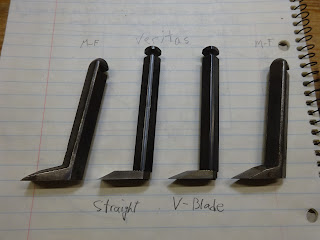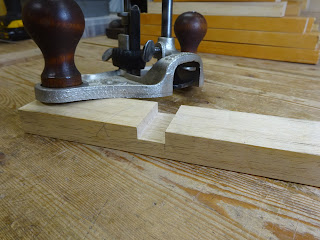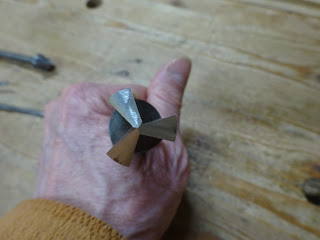The Millers Falls #67 router plane that I recently bought came with the 1/2" straight cutter as well as the 1/2" V-cutter (or spear-point). I started thinking about the V-cutter and wondered if it has any utility at all.
 |
| Millers Falls (left) and Veritas 1/2" spear-point cutters |
I've had the Veritas router plane for several years now and I got the 1/4" and 1/2" straight cutters, as well as the 1/2" V cutter. I use the two straight cutters all the time, but I don't think I've ever used the V-cutter.
Because the bottom (flat side) of a router's iron must necessarily be at an angle to the work (the clearance angle), the front edge of the iron is the only part that touches uncut wood.
 |
| Front view of the M-F V-cutter. This is what is presented to the wood. |
On a spear-point cutter, the very tip of the cutter is the lowest point on the cutter. As one moves away from the very tip along the cutting edges on either side, one gets higher above the tip because of the clearance angle of the iron. For this reason, this type of cutter cannot cut a flat bottom in a dado. It must cut a low angled V-shape into the wood.
 |
| "Head-on" view of Veritas V-cutter protruding through auxiliary base |
The picture above might show this a bit better. The arrow points to the leading tip of the V-cutter and the red line represents the surface of a piece of wood (or bottom of a dado) it's about to cut. The very tip of the cutter contacts the wood and as the router is pushed forward (typically for cross-grain dadoes), the point will want to dive into the wood as it pulls up wood fibers to each side of center.
 |
| Veritas 1/2" straight cutter |
The above picture shows a straight cutter doing its thing. Some wood fibers get torn up at each side of the leading edge, but the surface that is left is far better than a V-cutter could possibly leave.
Bob (of the Valley Woodworker blog) commented recently that he finds the V-cutter to be very useful for cutting into tight corners. I respect Bob's knowledge and experience, but I just don't get it. Seems that if I've just cut a stopped dado and need to clean up the corners a little bit, I'm not going to change the router plane blade, set it to the exact right depth and clean out those corners: I'm going to get a chisel and my standard router plane iron and do it in one quarter of the time.
I did a little (very little) experimenting with the V-blade. To get a reasonably smooth bottom to the dado, you need to sweep left and right as you go forward because the very point is the only portion of the blade doing any cutting. Since almost all of the dadoes I cut are in the 1/2" to 7/8" width range, there's not a lot of room to be sweeping the cutter left and right.
 |
| Dado cut in poplar with the straight cutter |
 |
| Above dado cut a little deeper with the V-cutter |
The pictures might not show it too well, but the surface is a lot rougher after using the V-cutter. And this is soft poplar. I wonder how it would do in a harder wood.
Well, that's it. Does anybody out there actually use their V-cutter? If so, what are the circumstances where it comes in handy for you?

























